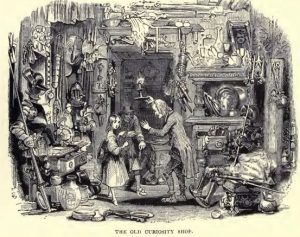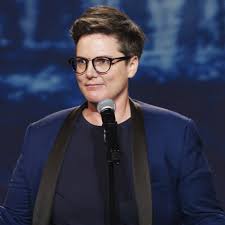by Shawn Crawford

In January of 1841, passengers arriving from Europe would be greeted by anxious New Yorkers on the docks. They all had the same question: “Is Little Nell dead?” Such was the anxiety caused by Charles Dickens’ novel The Old Curiosity Shop. But why couldn’t tortured New Yorkers simply read to the end of the book and relieve their fears?
Dickens’ work, like many Victorian novels, originally saw publication in serial form. Released monthly in periodicals or stand-alone as “part issues”, normally in three to five chapter installments, serial novels kept the public guessing and agonizing for up to two years. From the serial we derive the term “cliffhanger,” coined for the fraught dilemmas characters found themselves in at the end of an installment. In the case of serial master Wilkie Collins, often literally hanging from a cliff or heading over a waterfall. Spoiler alert: Little Nell dies. Readers in London and New York wept on the streets as they finished the installment describing her fate.
While a brilliant economic strategy, after serialization you could sell the book, the serial novel also offered the perfect form to entrance Victorian audiences. As Linda K. Hughes and Michael Lund point out in The Victorian Serial, personal development became an obsession in the Victorian mind. Serial novels mirrored their belief that personal and cultural progress was gradual, positive, and inevitable.
“Art isn’t art without form,” declares Markus Hinterhäuser, director of the Salzburg Festival. The festival under his leadership has shown a genius for finding just the right expression to re-imagine its classical repertoire for the current moment.
In her brilliant work, Psychology of an Art Writer (1903), Vernon Lee—the pseudonym of Violet Page—captures the relationship of content and form, “when we look at a picture or statue, we think the subject and feel the form, and express the first in rich and varied language intelligible to everyone, while we only indicate the effect of the other on us in vague terms not much more than translations or gestures.” Critics argue endlessly about the relationship between content and form, while the individual experiencing something for the first time says, “I just know that I like it.”
But in a time of crisis or rapid change, culture turns Lee’s insight on its head: we do nothing but feel the subject and give no thought to the form, or we dismiss it as suppression. This leads to the tyranny of declaring that no value exists in art unless it is making a Statement. Reviewing A.E. Stallings in the NYRB, Elisa Gabbert projects her anxiety of Stallings writing a poem about her child’s lice, “In this very socially conscious time, such references might betray an authorial worry: Are these poems relevant enough?” Gabbert could have easily continued, “And am I being relevant enough by reviewing them?” With an almost audible sigh of relief coming off the page, she then moves on to discuss Terrance Hayes, a poet with Relevance and Statements to spare.
Lately, however, there appears to be a dawning recognition that our content needs some form. In his thoughtful NYT essay, “The Unreality of Racial Justice Cinema,” Reggie Ugwu reflects on movies like Black KkKlansman and The Hate U Give and Get Out offering up tidy racial harmony or bloody revenge without providing any reality or insight to our present moment. In other words, meaningful content but the wrong form. Ugwu could have easily taken the next step to question whether movies still have the ability to address and explore our most contentious issues. Not that long ago Spike Lee wed content and form masterfully in “Do the Right Thing.” That feels as distant as a silent movie.
In the political realm, we can diagnose the hazards of ignoring form simply: The partisan divide created by the toxicity and misinformation of Facebook cannot be solved by more toxicity and misinformation on Facebook.
Once a form arises, our cultural tendency is to believe in its inevitability. We should really be asking, “what form should our social media and communications be taking given the technology that exists and the needs of a democratic society?” rather than assuming we can control and regulate Facebook and Twitter and Snapchat, etc. Mark Zuckerberg believes he can re-form his existing empire; I am suggesting the form of our current social media may be inherently destructive.

One of the most fascinating engagements with form has taken place in the world of comedy with Hannah Gadsby’s stand-up special “Nanette.” Little known in the U.S., Gadsby burst onto the scene when her Netflix show constructed a stand-up routine that questioned stand-up as a form she could inhabit. Can she find a voice in a form that privileges angry, male expression? Her conclusion: no. She then brilliantly pivots to her area of expertise and formal training, art history, to demonstrate that a narrative of suffering and abuse holds no allure when you exist on the receiving end. Art happens in spite of these thing, not because of them. None of which sounds like comedy, but Gadsby has to destroy the old form to forge a new one that contains laughs on her terms. She does so and in the process creates a new species of art that transcends the hollow form she embarked from to begin.
Thinking about a form that aligns with our cultural preoccupations takes us full circle back to the Victorian serial. Call it the Golden Age or Peak TV, but the television serial has managed to capture our age in a unique and meaningful way. The stories it can contain appear limitless, from the docuseries (Wormwood) to fantasy (Game of Thrones) to the gritty now (Sharp Objects). Unlike the Victorian desire for progress and improvement, television offers us the unfolding messiness and complications of existence we know cannot be expressed in a ninety-minute film. Television has the space and time to let a narrative unfold and wander. Television also elevates the writer over the director, allowing for richer storytelling. Movies now demand exorbitant costs that must be recaptured in an orgy of hype and explosions on opening weekend. Television is no hurry.
The television serial also allows for The Binge, a test of mettle that taps into our desire for everything extreme—sports, food, travel, and five seasons of Breaking Bad in one marathon sitting. In an age without heroes we contrive our own forms of heroism. Then we find a community, generally online, to celebrate our achievements and parse every nuance of meaning. All successful forms in our culture must now contain an element of self-congratulation.
We want to inhabit a world with echoes of this one but far enough removed to feel safe and in control. We want to be enthralled by a great story and then post how we would improve upon it. We desire a world we can share with friends we have never met in person, removing the disappointment and compromises that inevitably entails. Winter has come, and we’re all just trying to stay warm.
